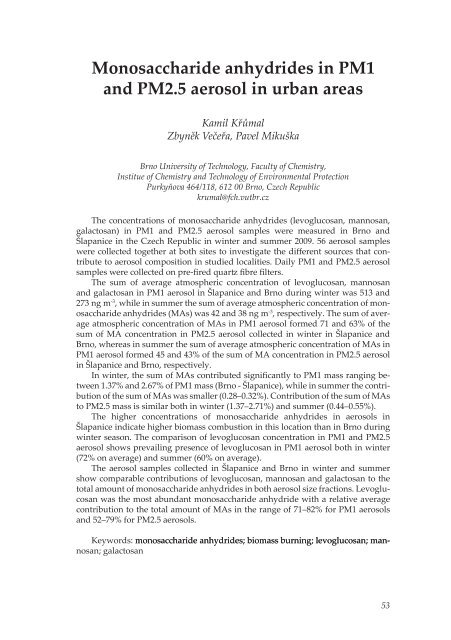Sborník abstraktů 2010 - Fakulta chemická - Vysoké učení technické ...
Sborník abstraktů 2010 - Fakulta chemická - Vysoké učení technické ...
Sborník abstraktů 2010 - Fakulta chemická - Vysoké učení technické ...
You also want an ePaper? Increase the reach of your titles
YUMPU automatically turns print PDFs into web optimized ePapers that Google loves.
Monosaccharide anhydrides in PM1<br />
and PM2.5 aerosol in urban areas<br />
Kamil Křůmal<br />
Zbyněk Večeřa, Pavel Mikuška<br />
Brno University of Technology, Faculty of Chemistry,<br />
Institue of Chemistry and Technology of Environmental Protection<br />
Purkyňova 464/118, 612 00 Brno, Czech Republic<br />
krumal@fch.vutbr.cz<br />
The concentrations of monosaccharide anhydrides (levoglucosan, mannosan,<br />
galactosan) in PM1 and PM2.5 aerosol samples were measured in Brno and<br />
Šlapanice in the Czech Republic in winter and summer 2009. 56 aerosol samples<br />
were collected together at both sites to investigate the different sources that contribute<br />
to aerosol composition in studied localities. Daily PM1 and PM2.5 aerosol<br />
samples were collected on pre-fired quartz fibre filters.<br />
The sum of average atmospheric concentration of levoglucosan, mannosan<br />
and galactosan in PM1 aerosol in Šlapanice and Brno during winter was 513 and<br />
273 ng m -3 , while in summer the sum of average atmospheric concentration of monosaccharide<br />
anhydrides (MAs) was 42 and 38 ng m -3 , respectively. The sum of average<br />
atmospheric concentration of MAs in PM1 aerosol formed 71 and 63% of the<br />
sum of MA concentration in PM2.5 aerosol collected in winter in Šlapanice and<br />
Brno, whereas in summer the sum of average atmospheric concentration of MAs in<br />
PM1 aerosol formed 45 and 43% of the sum of MA concentration in PM2.5 aerosol<br />
in Šlapanice and Brno, respectively.<br />
In winter, the sum of MAs contributed significantly to PM1 mass ranging between<br />
1.37% and 2.67% of PM1 mass (Brno - Šlapanice), while in summer the contribution<br />
of the sum of MAs was smaller (0.28–0.32%). Contribution of the sum of MAs<br />
to PM2.5 mass is similar both in winter (1.37–2.71%) and summer (0.44–0.55%).<br />
The higher concentrations of monosaccharide anhydrides in aerosols in<br />
Šlapanice indicate higher biomass combustion in this location than in Brno during<br />
winter season. The comparison of levoglucosan concentration in PM1 and PM2.5<br />
aerosol shows prevailing presence of levoglucosan in PM1 aerosol both in winter<br />
(72% on average) and summer (60% on average).<br />
The aerosol samples collected in Šlapanice and Brno in winter and summer<br />
show comparable contributions of levoglucosan, mannosan and galactosan to the<br />
total amount of monosaccharide anhydrides in both aerosol size fractions. Levoglucosan<br />
was the most abundant monosaccharide anhydride with a relative average<br />
contribution to the total amount of MAs in the range of 71–82% for PM1 aerosols<br />
and 52–79% for PM2.5 aerosols.<br />
Keywords: monosaccharide anhydrides; biomass burning; levoglucosan; manmonosaccharide<br />
anhydrides; biomass burning; levoglucosan; mannosan;<br />
galactosan

















